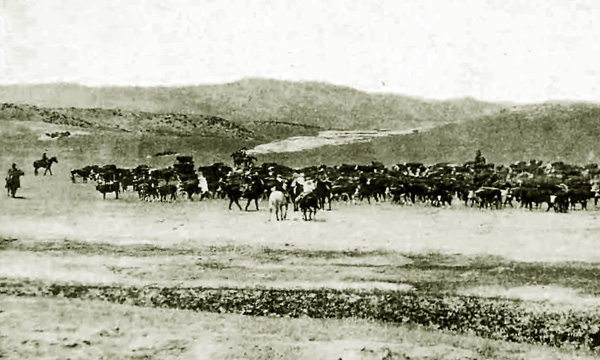
Roundup on Powder River near Buffalo, undated.
On April 10, 1884, the Democratic Leader published the descriptions and beginning dates of the various roundups
for 1884. Roundup No. 15 was thusly described:
No. 15
Commence May 15, 1884, at head of age creek: thence to O W ranch, down to
Old Woman to mouth, tbenoe up Lance creek to head; thence to head of Harney creek,
down Harney creek to mouth working Twenty Mile creek, thence across to Walker creek,
work to Beaver Dams on Lighting creek; thence to creek; thence to Cow creek;
thence down Snyder creek to mouth; thence up Lodge Pole to bead; thence down Black Thunder
to Cheyenne river; thence up Cheyenne river to mouth of Antelope, working Antelope and tributaries to head;
thence down Cheyenne river, working it and tributaries to month of Antelope, then work
Dry creek, Box creek and head of Lightning creek.
Fall round up to commence Oct. 15.
A. A. Spaugh foreman; Curtis Spaugh
assitant foreman, to the mouth of Black
Thunder.
Lee Moore, foreman; J. B. Moore,assistant,
foreman, from the mouth of Black
Thunder to the end of round up.
It proved to be the largest general Spring Roundup ever conducted in the state.
Some 200 men with 2,000 horse representing over 20 wagons participated. Over a six week period the
roundup gathered 400,000 head. The cattle companies participating included:
Tom Bell Cattle Co, Range, Lance Creek, 15,000 cattle.
Boyd Bros. OU. Range, Cheyenne River, 10,000 cattle.
J.M. Carey & Bro., CY, Range, Platte River, 60,000 cattle.
Carlisle Cattle Co, COD, Range, Powder River, 10,000 cattle.
Concord Cattle Co., COD, Range, Powder River, 10,000 cattle.
C. F. Coffee, 010 Bar, Range, Hat Creek Basin, 10,000 cattle.
M.O. Connors, MC, Range, Powder River, 8,000 cattle.
Converse Cattle Co., OW, Range, Lance Creek , 40,000 cattle.
Dater Bro. & Co., O Bar O, Range, Cheyenne River, 15,000 cattle.
Davis & Robins, Spectacle Brand, Powder River, 9,000 cattle.
J. H. Ford, A. Range, Cheyenne River, 12,000 cattle.
Plunket Cattle Co., EK, Range, Powder River, 15,000 cattle.
Dr. E. B. Graham, 04, Range, Running Water, 8,000 cattle.
Hammond Cattle Co., 4W, Range, Cheyenne River, 9,000 cattle.
Mike Henry, 88, Range, Cheyenne River, 8,000 cattle.
T. B. Hord, 77, Range, Lance Creek, 7,000 cattle.
Geo. Keeline & Sons, Hog Eye Brand, Platte River, 15,000 cattle.
Ogallala Cattle Co., Keystone Brand, Cheyenne River, 60,000 cattle.
Union Cattle Co., Bridle Bit, Range, Cheyenne River, 50,000 cattle.
Suffolk Cattle Co., AU7, Range, Cheyenne River, 25,000 cattle.
Circle Bar Outfit, Range, Indian Creek, 30,000 cattle.
Bar T. outfit, Range, Indian Creek, E. W. Whitcomb, 15,000 cattle.
Major Wolcott, VR, Range, Platte River, 15,000 cattle.
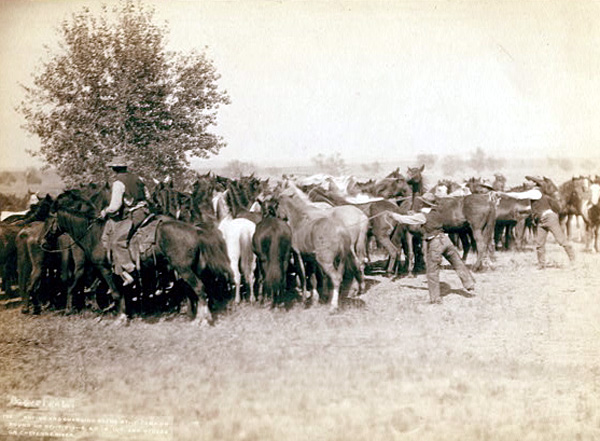
Changing Horses on Roundup along the Cheyenne River at the "T" camp, 1886, photo by J. Grabill
The roundup depicted included, in addition to the "T," the "999," the "AU7," and
the "S & G." The 999 Ranch was located in the area north of Manville and south of Powder River, the
AU7 was on the Cheyenne River, and S & G was just across the South Dakota boundary in Custer County west of Pringle.
John C. H. Grabill, started a photography studio in Sturgis, Dakota Terr., in 1886. His photographs taken
over a five year period up to 1891, are regarded as a primary source for documentation
of the life on the plains of Colorado, Wyoming and Dakota Territory. He is most
famous, however, for taking a series of photos of the aftermath of Wounded Knee.
As previously indicated, a cowboy while on roundup would have to
change multiple horses in order to avoid having the horses winded. There would be as many as
ten horses for each cowboy. Grabill's notes indicate that the cowboy on foot to the right of center is
William Cool. The method used by Cool of roping the horse by tossing a loop from about
chest high from one's side is called "throwing a hoolihan." See words to I Ride an Old Paint at botton
of page. The gentle throw is less likely to
spook the horses within the remuda than roping from above one's head. In bulldogging, the term "hoolihan" or "houlihan" also
refers to leaping from one's horse to the back of the neck of a steer bringing the animal down from the force
of the leap, rather than by bringing the steer down by twisting the horns. It is improper to do
a houlihan in bulldogging.
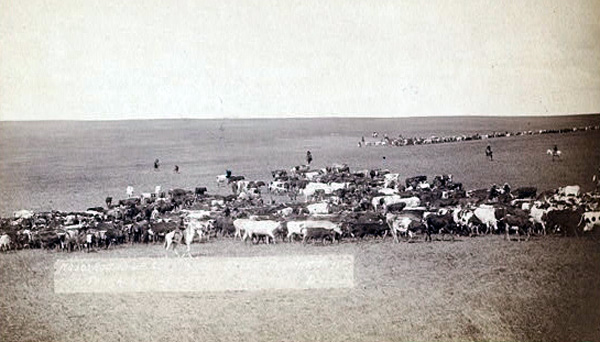
Roundup Along the Belle Fourche, 1890, photo by John C. H. Grabill.
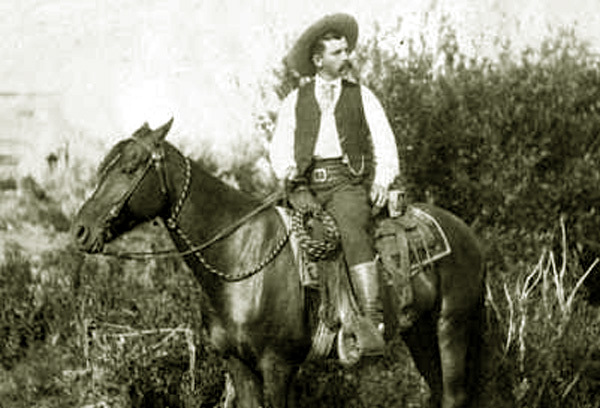
Addison A. Spaugh, foreman Converse Land Co. (the OW), on his horse "Old Cotton, Roundup No. 15, 1884.
The Converse Cattle Company (the "OW") was established in 1880 by
H. S. Manville and James Peck on the Old Woman Branch of the Cheyenne. The headquarters was located by
Manville and Spaugh about seven miles west of the Hat Creek Stage Station. Spaugh (1857-1943) trailed cattle north from
Texas at about age 14 with Mac Stewart and James H. Cook. Cook later became a scout for the Gen. Miles and was
at Wounded Knee. In his 1925 Fifty Years on the Old Frontier As Cowboy, Hunter, Guide, Scout, and Ranchman
Cook wrote:
By the time we got to Indian Territory we were all about played out. It
had been raining a great deal, and we had lost a lot of sleep. One night
we had a terrible storm and were up all night. It rained all the next day,
and we were with the cattle again all that night. The rain continued the
following day, and when night fell every old cowboy in the outfit -- that is,
those over thirty years of age -- quit the herd and went to camp, where they
lay down in the mud. They said they could not stand it any more and must
have rest. The only ones who stayed with Mac Stewart (for he was with the
cattle all the time, and would have fallen dead from his saddle before he
would ever have let them get away from him) were three very young cowboys
named Charley Dyer, Bert Helbert, and Addison Spaugh, and myself. I could
scarcely keep myself awake at all, and would even go to sleep riding along,
in spite of myself. At last I went to the wagon, got a piece of tobacco
from the cook, and repeated my old trick of rubbing some of the spittle on
my eyelids and into my eyes. By thus torturing myself I kept going. The
cattle were so nearly worn out by this time that they could not run, but
kept drifting about all night. In the morning the sun came out warm and
bright, and the cattle, after grazing a while, all lay down to rest.
It was not unusual for cowboys to be in their early teens. Cook, himself,
left home at age 11 and trailed cattle to Kansas at age 13. Thus, a 30-year old cowboy
would, indeed, have been old.
Spaugh ultimately went into
business himself. In 1901, Spaugh was indicted and convicted in federal court of illegally fencing off
225,000 acres of open range near Manville, west of Lusk. After the fencing was removed, he
was sentenced to one day in jail and a $50.00 fine. Spaugh is using a "Cheyenne" saddle.
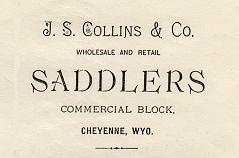 The Cheyenne saddles were
popular on trail drives and were manufactured by Frank Meanea of Cheyenne, F. L. Gallatin of Denver and
and the Collins Brothers (John S. and Gilbert H. Collins), who had shops in Omaha, Cheyenne, and Miles City. Spaugh's saddle appears
to have been made by J. S. Collins. The Collins Brothers started making saddles in Laramie City in 1872, and opened a
shop in Cheyenne in 1876. The brothers supplied
saddles to among others Buffalo Bill's Wild West Show. Theodore Roosevelt had a
Collins holster. The shop
in Cheyenne, located on 16th Street (see business card to above right),
closed in 1885. Gilbert Collins died in 1880 and John S. Collins died in 1910.
The Cheyenne saddles were
popular on trail drives and were manufactured by Frank Meanea of Cheyenne, F. L. Gallatin of Denver and
and the Collins Brothers (John S. and Gilbert H. Collins), who had shops in Omaha, Cheyenne, and Miles City. Spaugh's saddle appears
to have been made by J. S. Collins. The Collins Brothers started making saddles in Laramie City in 1872, and opened a
shop in Cheyenne in 1876. The brothers supplied
saddles to among others Buffalo Bill's Wild West Show. Theodore Roosevelt had a
Collins holster. The shop
in Cheyenne, located on 16th Street (see business card to above right),
closed in 1885. Gilbert Collins died in 1880 and John S. Collins died in 1910.
Spaugh was not, however, the only one who fenced in open range. In the early 1880's, Alexander Swan,
H. B. Kelly, and John Hunton predecessor owners of the Two Bar had each fenced extensive areas of public land. Ultimately,
under court order,
they removed the fencing. Additionally, other methods of land grabbing were utilized.
Land could be purchased on the cheap by claiming that irrigation had been established. Thus, the Union
Cattle Company and the Goshen Hole Ditching Company filed extensive claims, using as
proof of irrigation the plowing of a single furrow thirty-five miles long. F. E. Warren claimed large
tracts of land by claiming that he had resided upon it. At the same time, however,
Warren had served as City Councilman in Cheyenne. Indeed, the practice of claiming large tracts led to
the sarcasm by cowboy Frank Benton in his 1903 Cowboy Life on the Sidetrack as to his arrival in
Cheyenne:
We then started out to see the town. We asked an expressman on the corner of Main Street--he was the
only live human being in sight--what was the main featues of Cheyenne. He said Tom Horn and Senator Warren. We asked him what they was noted
for, and he said that Tom Honr was noted for killing people that took things that didn't belong to them
and then blowing his horn about it afterwards, and Senator Warren was noted for building wire fences on government
land and taking everything in sight. Cowboy Life on the Sidetrack p. 77.
Another tactic in controlling open range was to control
the water. Thus, as an example, the giant Pratt and Ferris Cattle Company simply diverted
Rawhide Creek, allegedly for irrigation, and gained control over forty-five
miles of land. Swan's Two-Bar, by controlling most of the
access to the Chugwater, was able to effectively control large areas of public land. Others simply
bought every other section, checkerboard fashion, and were able to have exclusive control of the
remaining sections by denying access to others. For discussion of "checkerboard control" see
Johnson County War
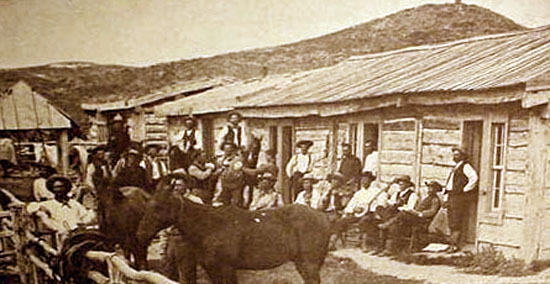
Bunkhouse, Converse Cattle Co., the "O W," 1883
Among those in the above photo are Joe Ryan leaning against fence, Frank W. DeCastro and Orville L. Vincent in pugulistic
pose to left of center in photo. DeCastro later acquired his own spread in Niobrara County and Vincent in
Goshen County. Addison Spaugh is standing in doorway at the right in the photo. Others who went out on
their own in the photo include Bill Mitchell mounted on horse nearest building, Frank A. Watt on horse left of
Mitchell, and Jack Blackwell seated to left of individual holding banjo (next to second door from the right).
An assistant foreman for the 1886 Wyoming Stock Growers Association Roundup was a
29 year-old cowboy, John B. Kendrick (1857-1933). Kendrick was originally from Texas
and first came to Wyoming on a cattle drive in 1879. By 1882 he had established his own herd. In
1887, he was named as superintendent for the OW. He moved its
operations two years later from eastern Wyoming to southern Montana and northern Wyoming. The OW range extending as far south as Dutch Creek
between Sheridan and Buffalo. Dutch Creek flows northward and is a tributary of Prairie Dog Creek which in turn flows northward into the
Tongue.
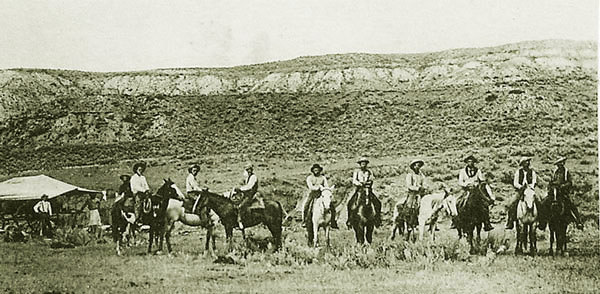
Roundup along Dutch Creek, undated.
Under Kendrick's leadership, the OW ultimately grew to control 210,000 acres, deeded and leased.
In Sheridan his investments included banking, newspaper, and hotel interests.
Kendrick was elected governor in 1915, only the second Democrat to so serve. Kendrick served
in the U.S. Senate from 1917 to his death in 1933. In the Senate he helped expose the
Teapot Dome scandal and helped provide funding for the preservation of the Longhorn
which was facing extinction.
Music this page:
I Ride an Old Paint
as performed by
Carl Sandburg
chorus:
Ride around, little dogies
Ride around them slow
For the fiery and snuffy are a-rarin' to go
verses:
I ride an old paint
I lead an old Dan
I'm goin' to Montan'
For to throw the hoolihan
They feed in the coulees
They water in the draw
Their tails are all matted
Their backs are all raw
(chorus)
Old Bill Jones
Had two daughters and a song
One went to Denver
And the other went wrong
His wife she died
In a poolroom fight
Still he sings
From morning till night
(chorus)
O when I die
Take my saddle from the wall
Put it on my pony
Lead him out of his stall
Tie my bones to his back
Turn our faces to the west
And we'll ride the prairies
That we love the best
(chorus)
Next Page, Roundups continued.
|